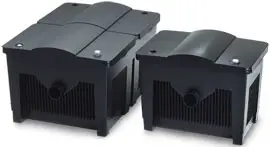Selecting, installing and maintaining a Pond Filter
A pond filter is one of the most important parts of any garden pond whether it be a fish pond or a simple water garden. These devices come in several different configurations and levels of price and complexity. Depending on one's pond design, a filter, aerator and pump will all be a necessity. These devices can be installed at different positions within or outside the pond, depending on the type chosen, and each has their own advantages and disadvantages.
The simplest type of pond filter is a basket type. These may be stationed at the surface of the pond or underwater depending upon their design. These work by forcing the water through a net which captures larger debris and then return the water to the pond. These filters are a basic necessity for any pond. There are various types of filters available which can remove debris of greater or smaller sizes. The basket will need to be cleaned from time to time to avoid clogging. This is done according to the schedule designed by the manufacturer of the device.
A pond UV filter is one of the more advanced types on the market. This garden pond filter proves that the old axiom "sunlight is the best disinfectant" is essentially true. More specifically, it is the UV radiation in sunlight that kills algae and microorganisms so efficiently. These filters expose quantities of the water to a powerful UV light that destroys microorganisms and algae which pose a hazard to fish. This type of filter does require cleaning. The UV bulb housing may become encrusted with grime after a time and this needs to be removed so that the maximum possible amount of UV light is delivered to the water that travels through the pump. These pumps generally take a small amount of water through them at a time. They're an excellent enhancement but, in and of themselves, they generally can't handle a quantity of water sufficient to provide for the safety of all the water in the pond.
A bacterial filter uses living organisms to purify the water of organisms that prey on fish and other pond-dwellers. These have to be primed with bacteria before they are set to work cleaning the water. Usually, they are reprimed frequently during the first few weeks of use, according to the manufacturer's instructions and then at longer intervals thereafter. Bacterial filters work best against algae and other "pond scum" type pollutants. When one switches on a particulate filter, such as the aforementioned basket type, the results will be visible before too long. A bacterial filter may take a while; even as long as a couple of months to clean up water that has become fouled. These garden pond filters should be installed before an algae problem manifests to avoid having to clean up the mess after the pond plants have established themselves.

The pond volume will have a significant effect on the results of any given type of filtration. Pond filters are not the area where one should consider cutting corners, to be certain. They should have the capacity to filter at least half of the total water volume every hour, or all of the water every hour for a koi pond. For large ponds, obviously, one should anticipate spending a decent amount of money on filtration technology. While this may seem excessive, without proper filtration the fish will inevitably become sick and die.
Filter maintenance can be something of a chore but, for those who love working in their gardens, it does add another task which is gratifying to learn and which will improve the quality of one's pond. Maintenance will depend greatly upon its location. Obviously, the filters that are stationed below the waterline involve a more complex set of procedures and one should anticipate that cleaning these devices will take at least a couple of hours. Above the water filters and skimmers are much easier to clean. One should adhere to their regular maintenance schedule as determined by the manufacturer even if the pond appears to be clean. However, if the water seems to be getting dirty, the first place to look is at the filters.
Some pond filters will have to be dug out of the ground to be fully cleaned. Others will simply have to be disassembled. In the case of a basket filter, this task is very easy. One simply disassembles it and cleans out the individual parts using a hose, puts the apparatus back together and sets it working again. In the case of a biological type, the process will be similar but one should consider refreshing the bacteria at the same time that they clean out the filter. If algae or other nuisances are becoming a problem, it's generally best to cover all of one's bases.
Always inspect the parts thoroughly. One should make certain they keep all their documentation so that they have an idea of what each part should look like which will make it much easier to determine if something is damaged or broken. When cleaning the parts, make sure that they all function as intended before replacing them in the filter. If one happens to go bad, most pond aficionados recommend that it is replace it with the same type of pond filter unless a switch was pre-planned. Changing the type of filter will affect the volume of the water being treated and doing so spontaneously simply because one's old filter has broken may upset the pond.
Pond filters can be very expensive but, as is the case with most purchases, one does get what one pays for. The most expensive filters are generally more durable, efficient and effective than their discount cousins. One may save a few dollars by purchasing a cheaper unit but that savings is oftentimes offset by the amount of time that one will spend cleaning and maintaining the cheaper unit. Make certain to follow the manufacturer's instructions to the letter when installing any filtration device into a pond.

